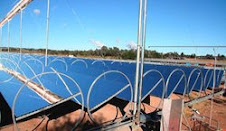Canadian Homebuilder's energy plan goes green
from TheStar.com - Business:
http://www.thestar.com/printArticle/274220
Reid's Homes is constructing a Kincardine, Ontario subdivision that's heated and cooled entirely by geothermal power
November 07, 2007
Tyler Hamilton, Star Energy Reporter
Homebuyers have for years been hearing about the "green" benefits of using geothermal energy to heat and cool a residence, but ask most home builders in Canada's risk-averse housing sector if they plan to embrace the technology and the excuses start flying.
Geothermal systems and other technologies aimed at improving a home's energy efficiency are too expensive and complex to install, they argue. This has left most projects over the past decade in the hands of architects, custom-home builders and principled homeowners looking to do their own retrofits.
Now, one of the largest home builders in southern Ontario is breaking from the pack. Reid's Heritage Homes has unveiled plans to build the province's first residential community to be heated and cooled entirely with geothermal energy.
The 150-home subdivision will be located in Kincardine, about three hours northwest of Toronto, and could prove a wake-up call for other home builders across Ontario that have resisted the trend.
"Geothermal is going to be standard on all the homes," said Paul Mertes, chief executive officer of Clean Energy Developments, the Toronto-based company that is designing and installing the systems for Reid's Heritage.
He estimated that the systems, including radiant heating in the floors, add a premium of $10,000 to $12,000 on each home.
"It's pretty exciting," he said.
Reid's made headlines earlier this year when one of its homes in Guelph became the first in Canada to get LEED (leadership in energy and environment design) certification. It was also one of only a handful of homes in North America to achieve LEED's rigorous platinum rating.
Reid's spokesperson Rebecca Mountain said focus groups showed that 77 per cent of potential home buyers would prefer to purchase a property that was cooled and heated with geothermal energy, even if it came with a premium.
Based on that feedback, the company decided to make it a standard feature in its Kincardine development and likely for future projects, including a 1,000 home community in Owen Sound. Each home is expected to achieve 60 per cent energy savings.
"You pay the thing back in 4.7 years. That's a pretty fast payback," said Mountain, adding that consumers are increasingly looking at the ongoing costs of home ownership, not just an upfront price tag, when shopping around for a property.
Geothermal or "geoexchange" systems are based on technology that's decades old. They take advantage of the fact that two metres or more below the Earth's surface the temperature is a constant 10 to 15 degrees Celsius.
The systems work by circulating a glycol solution underground through a grid of tubing. The glycol absorbs heat from the ground in the winter and dumps it there in the summer, and a device called a heat pump manages the balance by switching between heating and cooling, depending on outside temperatures.
It's considered a clean-energy technology because it eliminates the need for natural gas or oil, though electricity is required to run the heat pump.
"Every subdivision should be done this way," said Ron Dembo, whose Toronto-based company Zerofootprint Energy is trying to push for broader acceptance of the technology. "It's such a no-brainer."
The systems are easier and less expensive to install in new subdivisions because, unlike retrofits on existing homes, all ground drilling, tube laying and equipment installation can be done before grass is laid and basements are finished, Mertes said.
Home developer Marshall Homes announced in February 2006 that it would give homebuyers the option of having a combined geothermal-solar system installed in homes at its Copperfield community in Oshawa.
The difference with the Reid's announcement is that there will be no option – all 150 homes will come with geothermal as a standard feature.
There are 200,000 new homes being built each year across the country, according to Statistics Canada. Provincial governments need to upgrade building codes to make it easier for home developers to pursue geothermal as a standard offering in planned communities, said Dembo. "This needs to happen on a big scale."
Clean Energy Developments was created to guide home developers in that direction. William Tharp, chief executive of Climate Change Infrastructure, a major investor and co-founder of Clean Energy, said the Kincardine subdivision is a major step for green housing in Ontario.
"There is no question that the scale of this residential project and the financial and market commitment being made by both the company and a leading property developer are ground-breaking," Tharp said.
"Financially, it's very viable – from homeowner through to developer, and from a climate change or environmental position, it's clear leadership."
Online Directory of Geothermal Energy Stocks
Best Green Stocks Investing Blog
Subscribe to:
Post Comments (Atom)
Yuya Joe Blog
Lake Ontario Waterkeeper
The Daily Beast -Politics Blog
21stArch.com - 21st Century Architecture
Original Joe College Blog
WikiLeaks Foreign Policy Analysis
AGreenRealtor.com Real Estate Blog - Ecology Energy Efficiency
Best Green Stocks Investing Blog
PV Intell Photovoltaic Solar Stocks Investing
SEARCH Leading Alternative Energy and Ethical Investing websites

Custom Search
Daily Kos
Rare Earth Stocks Research
Patrick MacManus's Blog Peace and Collaborative Development
BeesTreesFrogsElephants.com - Nature and Ecology Blog
Research Green Energy stocks, Clean Energy investing information
Find wind power investing info online, clean energy mutual funds, geothermal stocks, solar energy investments.

Green Energy Investing Network:
Green Stocks Investing Clean Power Blog
SolarIntell.com Renewable Power Investing Website
Wind Intell.com Wind Energy Stocks Company Links
Geothermal Power Investing Public Companies
PV Intell.com Leading Photovoltaic Solar Energy Stocks

Custom Search
Green Energy Investing Network:
Green Stocks Investing Clean Power Blog
SolarIntell.com Renewable Power Investing Website
Wind Intell.com Wind Energy Stocks Company Links
Geothermal Power Investing Public Companies
PV Intell.com Leading Photovoltaic Solar Energy Stocks







No comments:
Post a Comment